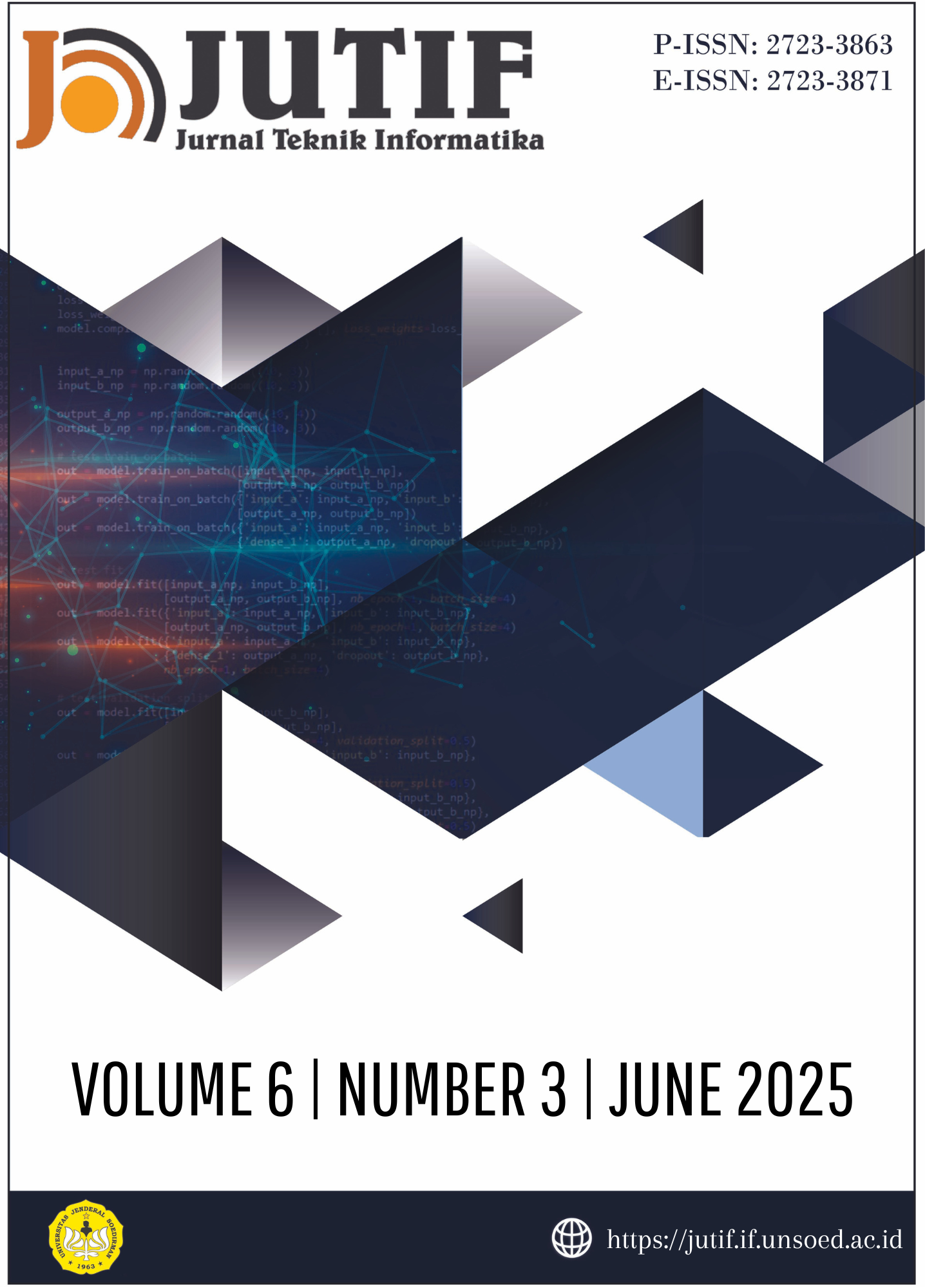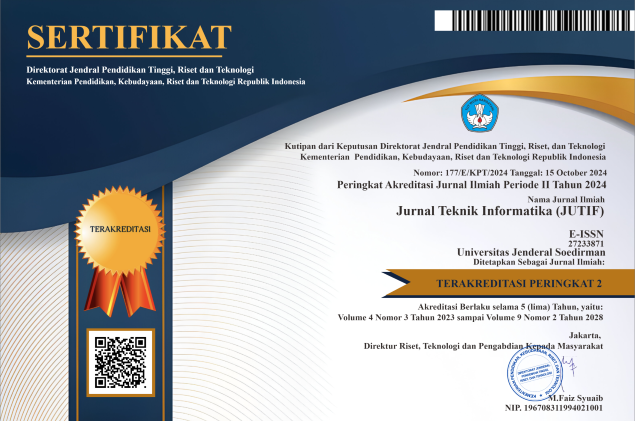Optimization Of Extreme Learning Machine Models Using Metaheuristic Approaches For Diabetes Classification
DOI:
https://doi.org/10.52436/1.jutif.2025.6.3.4690Keywords:
Activation Function, Diabetes, Extreme Learning Machine, Metaheuristic, SMOTEAbstract
Proper classification of diabetes is a significant challenge in contemporary healthcare, especially related to early detection and clinical decision support systems. This study aims to optimize the Extreme Learning Machine (ELM) model with a metaheuristic approach to improve performance in diabetes classification. The data used was an open dataset containing the patient's medical attributes, such as age, gender, smoking status, body mass index, blood glucose level, and HbA1c. The initial process includes data cleansing, one-hot coding for categorical features, MinMax normalization, and unbalanced data handling with SMOTE. The ELM model was tested with four activation functions (Sigmoid, ReLU, Tanh, and RBF) each combined with three metaheuristic optimization strategies, namely Particle Swarm Optimization (PSO), Genetic Algorithm (GA), and Bat Algorithm. The results of the evaluation showed that the combination of the Tanh activation function with GA optimization obtained the highest accuracy of 87.98% and an F1-score of 0.5489. Overall, GA optimization appears to be superior to all other measurement configurations in consistent classification performance. The main contribution of this study is to offer a systematic approach to select the best combination of activation functions and optimization algorithms in ELM, as well as to provide empirical evidence to support the application of metaheuristic strategies to improve the accuracy of disease classification based on health data. This research has direct implications for the development of a more precise and data-based medical diagnostic classification system for diabetes.
Downloads
References
J. S and U. H. R., ‘A Comparative Study Of Diabetes Trends: India And Selected Countries’, Global Journal For Research Analysis, pp. 50–54, Feb. 2025, doi: 10.36106/gjra/5404887.
K. Manglani et al., ‘Correlation of Leptin in Patients With Type 2 Diabetes Mellitus’, Cureus, Apr. 2024, doi: 10.7759/cureus.57667.
L. S. Satin, S. A. Soleimanpour, and E. M. Walker, ‘New Aspects of Diabetes Research and Therapeutic Development’, Pharmacological Reviews, vol. 73, no. 3, pp. 1001–1015, Jul. 2021, doi: 10.1124/pharmrev.120.000160.
S. Akhtar, ‘Diabetes-induced peripheral neuropathy: Is prescribing physical exercise the answer?’, Biomol Biomed, vol. 24, no. 3, pp. 436–439, May 2024, doi: 10.17305/bb.2023.10188.
J. Patel, N. Null, N. Null, N. Null, N. Null, and N. Null, ‘Diabetes, A Global Epidemic’, SACAD, 2023, doi: 10.58809/HBJV7965.
A. Kumar, R. Gangwar, A. Ahmad Zargar, R. Kumar, and A. Sharma, ‘Prevalence of Diabetes in India: A Review of IDF Diabetes Atlas 10thEdition’, CDR, vol. 20, no. 1, p. e130423215752, Jan. 2024, doi: 10.2174/1573399819666230413094200.
X. An et al., ‘Early effective intervention can significantly reduce all-cause mortality in prediabetic patients: a systematic review and meta-analysis based on high-quality clinical studies’, Front. Endocrinol., vol. 15, p. 1294819, Mar. 2024, doi: 10.3389/fendo.2024.1294819.
K. C. Alaga and J. Haddad, ‘Lifestyle intervention is superior to metformin in prevention of microvascular complications of diabetes in women, but socioeconomic barriers may lead to use of combination’, Clin Res Pract, vol. 7, no. 2, p. crp.eP2626, Oct. 2021, doi: 10.22237/crp/1625098080.
B. P. Ooi, N. A. Rahim, M. J. Masnan, and A. Zakaria, ‘A study of extreme learning machine on small sample-sized classification problems’, J. Phys.: Conf. Ser., vol. 2107, no. 1, p. 012013, Nov. 2021, doi: 10.1088/1742-6596/2107/1/012013.
Y. Zhang et al., ‘An Improved Extreme Learning Machine (ELM) Algorithm for Intent Recognition of Transfemoral Amputees With Powered Knee Prosthesis’, IEEE Trans. Neural Syst. Rehabil. Eng., vol. 32, pp. 1757–1766, 2024, doi: 10.1109/TNSRE.2024.3394618.
T. Chouikh, H. Hellara, R. Barioul, F. Sandid, and O. Kanoun, ‘Comparative Study of Optimization Methods Proposed for the Extreme Learning Machine (ELM)’, in 2021 International Workshop on Impedance Spectroscopy (IWIS), Chemnitz, Germany: IEEE, Sep. 2021, pp. 137–140. doi: 10.1109/IWIS54661.2021.9711902.
P. Sun and L. Yang, ‘Generalized eigenvalue extreme learning machine for classification’, Appl Intell, vol. 52, no. 6, pp. 6662–6691, Apr. 2022, doi: 10.1007/s10489-021-02654-2.
L. Tobar-Valenzuela, M. Mora, F. Silva-Pavez, I. Torres-Gonzalez, and P. Barria-Valdebenito, ‘Fast Tuning of Extreme Learning Machine Neural Networks based with Simple Optimization Algorithms’, in 2022 IEEE International Conference on Automation/XXV Congress of the Chilean Association of Automatic Control (ICA-ACCA), Curicó, Chile: IEEE, Oct. 2022, pp. 1–5. doi: 10.1109/ICA-ACCA56767.2022.10005961.
J. Wang, S. Lu, S. Wang, and Y. Zhang, ‘A review on extreme learning machine’, Multimedia Tools and Applications, vol. 81, pp. 41611–41660, 2021, doi: 10.1007/s11042-021-11007-7.
A. Al-Btoush, M. Fernandez-Delgado, E. Cernadas, and S. Barro, ‘Extreme learning machine with confidence interval based bias initialization’, in 2021 Second International Conference on Intelligent Data Science Technologies and Applications (IDSTA), Tartu, Estonia: IEEE, Nov. 2021, pp. 23–30. doi: 10.1109/IDSTA53674.2021.9660822.
L. Ding, X. Zhang, D. Wu, and M. Liu, ‘Application of an extreme learning machine network with particle swarm optimization in syndrome classification of primary liver cancer’, Journal of Integrative Medicine, vol. 19, no. 5, pp. 395–407, Sep. 2021, doi: 10.1016/j.joim.2021.08.001.
R. Gupta, A. Agarwal, D. Dua, and A. Yadav, ‘Android Malware Detection Using Extreme Learning Machine Optimized with Swarm Intelligence’, in Cyber Security and Digital Forensics, vol. 73, K. Khanna, V. V. Estrela, and J. J. P. C. Rodrigues, Eds., in Lecture Notes on Data Engineering and Communications Technologies, vol. 73. , Singapore: Springer Singapore, 2022, pp. 31–43. doi: 10.1007/978-981-16-3961-6_4.
Q. Fan and T. Fan, ‘A Hybrid Model of Extreme Learning Machine Based on Bat and Cuckoo Search Algorithm for Regression and Multiclass Classification’, Journal of Mathematics, vol. 2021, pp. 1–11, Nov. 2021, doi: 10.1155/2021/4404088.
R. Liu, L. Wei, and P. Zhang, ‘Extreme Learning Machine Classifier Based on Novel Particle Swarm Optimization Algorithm’, in 2023 38th Youth Academic Annual Conference of Chinese Association of Automation (YAC), Hefei, China: IEEE, Aug. 2023, pp. 1005–1009. doi: 10.1109/YAC59482.2023.10401835.
K. Tan, ‘Extreme Learning Machine based on Improved Multi-Objective Particle Swarm Optimization’, in 2024 5th International Conference on Computer Engineering and Application (ICCEA), Hangzhou, China: IEEE, Apr. 2024, pp. 333–337. doi: 10.1109/ICCEA62105.2024.10603496.
J. Deng, ‘The Data Preprocessing Technique in Machine Learning’, TE, vol. 1, no. 10, Dec. 2024, doi: 10.61173/0hfqqz07.
I. Chahid, A. K. Elmiad, and M. Badaoui, ‘Data Preprocessing For Machine Learning Applications in Healthcare: A Review’, in 2023 14th International Conference on Intelligent Systems: Theories and Applications (SITA), Casablanca, Morocco: IEEE, Nov. 2023, pp. 1–6. doi: 10.1109/SITA60746.2023.10373591.
N. Sigeef, ‘An Oversampling Algorithm combining SMOTE and RF for Imbalanced Medical Data’, IJRASET, vol. 11, no. 6, pp. 2429–2434, Jun. 2023, doi: 10.22214/ijraset.2023.54074.
Y. Lv, B. Li, J. Yu, and Y. Ding, ‘Reduce Training Error of Extreme Learning Machine by Selecting Appropriate Hidden Layer Output Matrix’, J. Syst. Sci. Syst. Eng., vol. 30, no. 5, pp. 552–571, Oct. 2021, doi: 10.1007/s11518-021-5502-8.
R. Kaloni, T. R. Nayak, M. Sankhe, and Mr. G. Wakure, ‘Optimized Extreme Learning Machine’, IJRASET, vol. 10, no. 4, pp. 1334–1345, Apr. 2022, doi: 10.22214/ijraset.2022.41514.
X. Liu, G. Zhou, Y. Zhou, and Q. Luo, ‘Functional extreme learning machine’, Front. Comput. Neurosci., vol. 17, p. 1209372, Jul. 2023, doi: 10.3389/fncom.2023.1209372.
A. Akusok, L. Espinosa-Leal, and K.-M. BjöRk, ‘Sharing non-reversible data statistics for fast and secure Federated learning native to Extreme Learning Machine’, in Proceedings of the 17th International Conference on PErvasive Technologies Related to Assistive Environments, Crete Greece: ACM, Jun. 2024, pp. 674–675. doi: 10.1145/3652037.3663891.
Monisha. P, A. ArunRaja, and J. Judeson Antony Kovilpillai, ‘Structural Health Monitoring Using Machine Learning Techniques’, in 2023 3rd International Conference on Pervasive Computing and Social Networking (ICPCSN), Salem, India: IEEE, Jun. 2023, pp. 275–282. doi: 10.1109/ICPCSN58827.2023.00052.
A. D. Roshan, P. Guha, and G. Trivedi, ‘Hardware-Optimized Regression Tree-Based Sigmoid and Tanh Functions for Machine Learning Applications’, IEEE Trans. Circuits Syst. II, vol. 72, no. 1, pp. 283–287, Jan. 2025, doi: 10.1109/TCSII.2024.3485493.
O. Pantalé, ‘Comparing Activation Functions in Machine Learning for Finite Element Simulations in Thermomechanical Forming’, Algorithms, vol. 16, no. 12, p. 537, Nov. 2023, doi: 10.3390/a16120537.
R. Çekіk, ‘Categorization of Turkish Text Documents Using Extreme Learning Machine’, in 2024 8th International Artificial Intelligence and Data Processing Symposium (IDAP), Malatya, Turkiye: IEEE, Sep. 2024, pp. 1–7. doi: 10.1109/IDAP64064.2024.10710721.
S. Manjula, N. Hema Rajini, and K. Chokkanathan, ‘Optimizing Chronic Kidney Disease Diagnosis: A Comprehensive Review of Metaheuristic Algorithms and Their Applications in Detection and Classification’, in 2024 8th International Conference on Electronics, Communication and Aerospace Technology (ICECA), Coimbatore, India: IEEE, Nov. 2024, pp. 1654–1660. doi: 10.1109/ICECA63461.2024.10801087.
C. Kaya, Z. H. Kilimci, M. Uysal, and M. Kaya, ‘A Review of Metaheuristic Optimization Techniques in Text Classification’, IJCESEN, vol. 10, no. 2, Apr. 2024, doi: 10.22399/ijcesen.295.
G. Phatai and T. Luangrungruang, ‘A Comparative Study of Hybrid Neural Network with Metaheuristics for Student Performance Classification’, in 2023 11th International Conference on Information and Education Technology (ICIET), Fujisawa, Japan: IEEE, Mar. 2023, pp. 448–452. doi: 10.1109/ICIET56899.2023.10111495.
K. Takahashi, K. Yamamoto, A. Kuchiba, and T. Koyama, ‘Confidence interval for micro-averaged F1 and macro-averaged F1 scores’, Appl Intell, vol. 52, no. 5, pp. 4961–4972, Mar. 2022, doi: 10.1007/s10489-021-02635-5.
B. Shannaq, O. Ali, S. A. Maqbali, and A. Al-Zeidi, ‘Advancing user classification models: A comparative analysis of machine learning approaches to enhance faculty password policies at the University of Buraimi’, J. Infras. Policy. Dev., vol. 8, no. 13, p. 9311, Nov. 2024, doi: 10.24294/jipd9311.
L. Bai, H. Li, W. Gao, and J. Xie, ‘A cooperative genetic algorithm based on extreme learning machine for data classification’, Soft Comput, vol. 26, no. 17, pp. 8585–8601, Sep. 2022, doi: 10.1007/s00500-022-07202-9.
Nur Azizah Janad, Junaidi, and Iman Setiawan, ‘Application Of The Extreme Learning Machine (Elm) Method In Predicting The Combined Stock Price Index (Ihsg) In Indonesia’, Tadulako Soc. Sci. Hum. J., vol. 2, no. 2, pp. 22–34, Jul. 2022, doi: 10.22487/sochum.v2i2.17382.
R. Siouda, M. Nemissi, and H. Seridi, ‘Diverse activation functions based-hybrid RBF-ELM neural network for medical classification’, Evol. Intel., vol. 17, no. 2, pp. 829–845, Apr. 2024, doi: 10.1007/s12065-022-00758-3.
A. Nozaripour and H. Soltanizadeh, ‘Sparse Representation Based on Modified Genetic Algorithm for Classification’, Iran J Sci Technol Trans Electr Eng, vol. 46, no. 3, pp. 819–827, Sep. 2022, doi: 10.1007/s40998-022-00499-0.
K. Kim, ‘Noise Avoidance SMOTE in Ensemble Learning for Imbalanced Data’, IEEE Access, vol. 9, pp. 143250–143265, 2021, doi: 10.1109/ACCESS.2021.3120738.
Additional Files
Published
How to Cite
Issue
Section
License
Copyright (c) 2025 Gilang Sulaeman, Yohani Setiya Rafika Nur Nur, Adanti Wido Paramadini, Dasril Aldo, M. Yoka Fathoni

This work is licensed under a Creative Commons Attribution 4.0 International License.



























